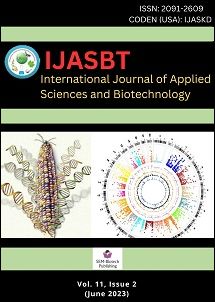Bioaccumulation and Health Risk Assessment of Heavy Metals in Some Fish Species Available in Local Fish Markets of Kathmandu, Nepal
DOI:
https://doi.org/10.3126/ijasbt.v11i2.56121Keywords:
Bioaccumulation, Fish species, Heavy metals, Health risk, KathmanduAbstract
In this study, concentrations of Cd, Cr, Mn, Pb, and Zn were determined by flame atomic absorption spectrophotometer (FAAS) in edible muscle tissues of a total of 25 fish samples belonging to five fish species viz., Hypophthalmichthys nobilis (Bighead), Wallago attu (Buhari), Catla catla (Catla), Clarias batrachus (Mugree), and Labeo rohita (Rohu) marketed in Kathmandu, Nepal and evaluated potential health risks for adults using USEPA deterministic approaches. The average metal accumulation in all fish species followed the order of Zn (27.89) > Mn (5.36) > Pb (2.37) > Cr (1.12) > Cd (0.44) mg/kg, exceeding the FAO/WHO guidelines except for Zn. Likewise, the sum of average metal concentrations (∑5HM) followed the descending order of C. catla (49.61) > C. batrachus (44.49) > W. attu (34.51)> H. nobilis (32.10) > L. rohita (25.18) mg/kg. The correlation matrix showed significant correlations among some HMs indicating their common sources of origin in the examined fish species. The estimated daily intakes (EDIs) of HMs were lower than the maximum tolerable daily intake (MTDI). The target hazard quotients (THQs) of a single element in all fish species were less than 1.0 while the total target hazard quotients (TTHQs) in C. batrachus, C. catla, and H. nobilis exceeded the safe limit of 1.0 suggesting a potential non-carcinogenic risk. Moreover, the target cancer risks (TRs) of Cd and Cr were higher than the acceptable risk limit (10−4) in all fish species suggesting that their consumption might pose a lifetime cancer risk for adults. Therefore, the study recommends regular monitoring of HMs in commercial fish to ensure the safety of consumer health.
Int. J. Appl. Sci. Biotechnol. Vol 11(2): 85-98.
Downloads
Downloads
Published
How to Cite
Issue
Section
License
Copyright (c) 2023 International Journal of Applied Sciences and Biotechnology

This work is licensed under a Creative Commons Attribution-NonCommercial 4.0 International License.




